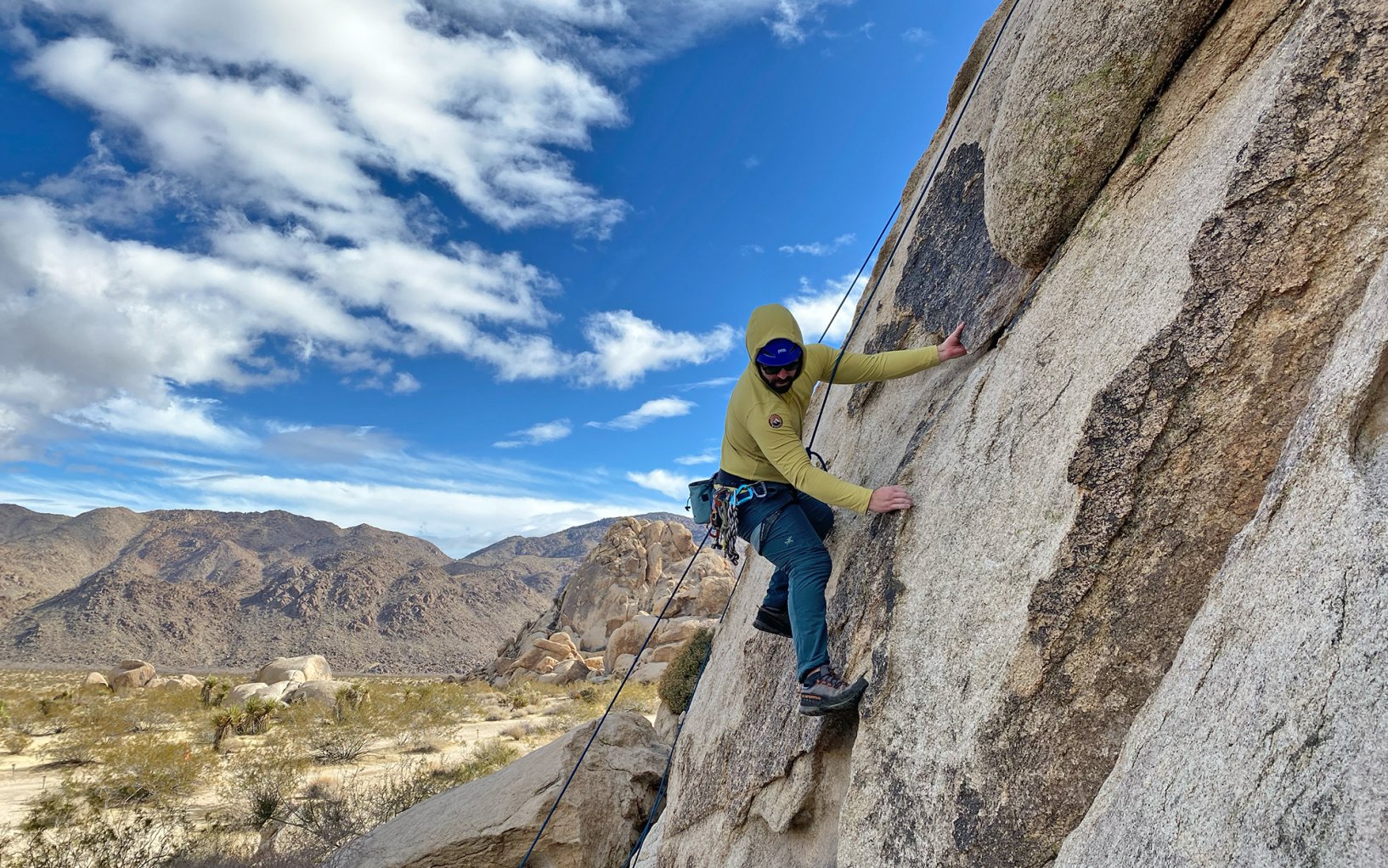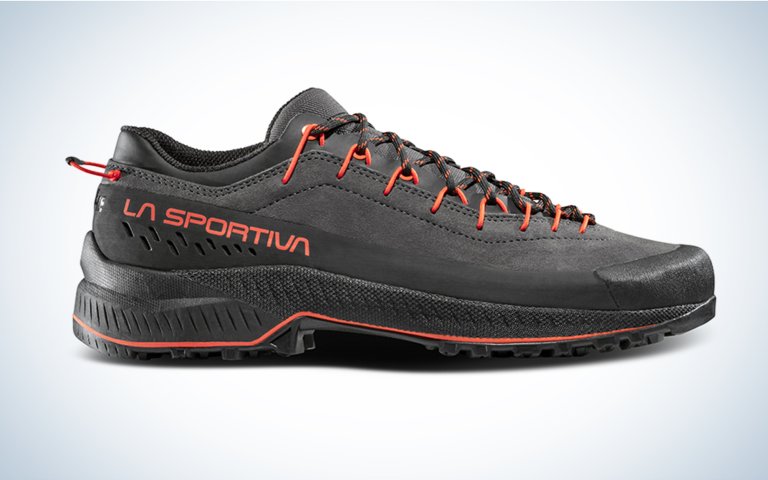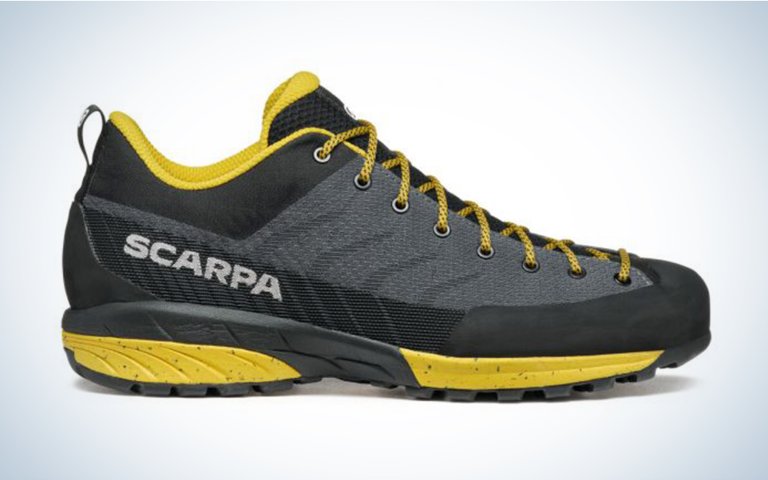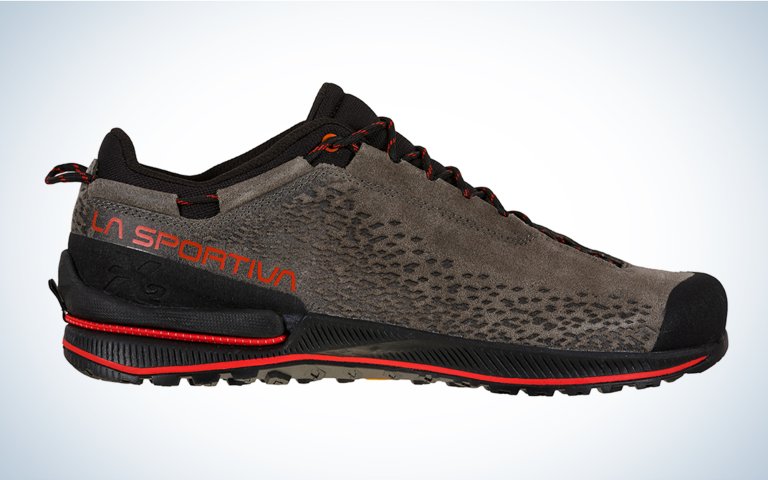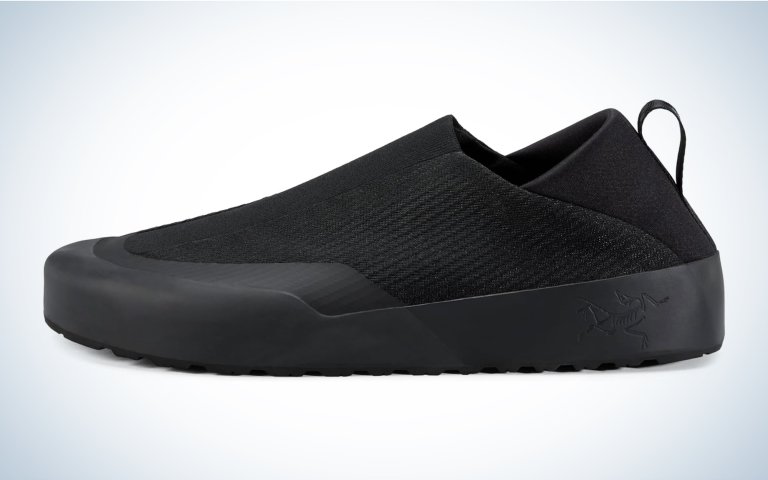We may earn revenue from the products available on this page and participate in affiliate programs. Learn More ›
Guiding alpine rock in the North Cascades, I rarely bring more than a pair of approach shoes and often advise my clients to do the same. So while the name “approach shoe” might sound like a hiking shoe, these shoes are designed and used for much more, including actual rock climbing. When approach shoes first came out, the idea was simple: Put sticky rubber soles on hiking shoes to increase security while approaching your climb. It didn’t take long for climbers to realize that comfortable shoes with sticky rubber on them could ascend pretty well. The market responded and brands started to design approach shoes specifically for technical climbing, with La Sportiva even boasting that you could climb 5.12 in their now discontinued Ganda approach shoes.
It turns out that having a shoe you can hike and climb in is a pretty desirable thing. There’s a lot of climbing out there that doesn’t require you to shove your feet into tight rock shoes. You can also save weight when you’re climbing in the backcountry if you only need one pair of shoes. Of course, when a product sets out to be so versatile, there is always going to be some give and take on how well it functions at any one thing. With this in mind, I set out to find the best approach shoes for all sorts of hiking and climbing occasions to find the best approach shoes in this highly versatile and variable product category.
- Best Overall: LaSportiva TX4 Leather
- Best Hiker: Scarpa Mescalito Planet
- Best Climber: LaSportiva TX2 Leather
- Best for the Crag: Arc’teryx Kragg Shoe
How I Tested the Best Approach Shoes

I tested the best approach shoes in the field. When something is billed as a “do it all” kind of product, you’ve got to do it all to figure out where it shines and where it falls short. For example, a shoe might have a thin sticky rubber sole for good precision while rock climbing, but that will mean less support for the foot while slogging on the trail. Or a shoe might be nice and roomy to allow your foot to splay while hiking, but that will translate to a sloppy feeling when trying to edge on the wall. How designers navigate these decisions ultimately decides where an approach shoe falls on the hiking to climbing performance continuum.
For this review, I hiked on trails, crossed talus fields, scrambled 4th class terrain, and climbed 5th class rock. Each shoe I tested did at least 2 miles of trail hiking and typically 5.8 difficulty in rock climbing. I focused on the fit and comfort while hiking with a pack on, support and stability in uneven or rocky terrain, and performance while technical climbing. I used shoes at the crag, in the alpine, and on both dry and rainy days to see how they’d perform when put through the wringer.
Best Approach Shoes: Reviews & Recommendations
Best Overall: LaSportiva TX4
Pros
- Thick sole for support and comfort on long hikes
- Leather molds to the foot over time
- Sole rubber is very sticky
Cons
- Toe box is big so edging can feel a little sloppy while climbing
- Don’t pack down very well
Key Features
- Weight: 26 ounces (pair)
- Leather upper
- Vibram MegaGrip sole
The beauty of an approach shoe is that it can be a quiver of one. Hike, scramble, and climb all day and never have to change footwear or waste space in your pack on an extra pair of shoes. In over 15 years of guiding in all kinds of terrain, the LaSportiva TX 4 is the best shoe I’ve used when it comes to doing it all.

I found the TX 4 comfortable while hiking with a pack on a trail up to 12 miles and navigating rocky, uneven terrain like talus fields. This is mostly thanks to the thicker sole on the midfoot and heel that provides foot support as well as the wide toe box that allows your forefoot to expand with the pressure of a loaded step. I love a leather constructed approach shoe because it tends to only get more comfortable over time as you sweat into the material and it molds to your foot.
The TX 4 also climbs incredibly well for how comfortable it is as a hiker. The sole of the shoe thins down at the toe to allow for more sensitivity and control while climbing and the Vibram rubber is very high friction for smearing after the tread has worn down a little bit. The only area this shoe left me wanting was when I tried to climb using my toe on small edges, as the extra room in the toe box lent to a sloppy feel. But a bit of this is to be expected with any approach shoe and I was still able to top rope 5.10 comfortably.
Lastly, this shoe isn’t designed to pack down super tight so it can be awkward if you have to put them in your small send pack or clip them to the back of your harness. Luckily, the TX 4 does so much so well that you likely won’t have to change into something else that often.
Best Hiker: Scarpa Mescalito Planet
Pros
- Thick sole provides cushion and support for long approaches
- Lacing system goes far down the toe so you can cinch it up tight when climbing
- Sticky rubber provides good friction when scrambling
- Lots of room for a high volume foot
Cons
- The thicker sole at the toe provides less sensitivity while climbing
- Doesn’t pack down well in a backpack
Key Features
- Weight: 26 ounces (pair)
- Eco fabric upper
- Vibram Dynamis LB/Megagrip sole
The Scarpa Mescalito Planet came very close to winning best overall in this review. In fact, it probably wouldn’t take much to convince me to change my mind because this shoe is so dang comfortable while hiking. But the supportive sole also means there’s a lot more material between your toe and the rock so there is a slightly clunky, uncontrolled feeling while climbing.
Still, this shoe is no slouch on the wall and I was able to climb low 5th class up to 5.8 quite comfortably which is more than I can say for a lot of approach shoes. One of the best features of this shoe is that the lacing system goes very far down the toe so when it’s time to send, you can dial in a tight fit by extracting all that comfy hiking room with a good cinch. This increases the precision while climbing and makes up for some of the unwieldiness of the sole.
This is by far the most comfortable approach shoe for hiking and scrambling. When I was younger, I used to weigh climbing ability far more than hiking comfort in an approach shoe. I’d just deal with the foot pain so I could climb a little harder on the rock. But now that my joints are a little creakier and there’s not quite as much tread on the tires, I’ve started to prioritize all day comfort over any other feature and the Mescalito Planet delivers. I’ve used these shoes for all day mountain pursuits on variable terrain and the support from the sole with the security of the sticky rubber combine to create efficient and comfortable travel.
The only reason I wouldn’t reach for the Mescalito Planet would be if it were going to spend the majority of the day in my backpack or clipped to my harness. The bulkiness of this shoe is not insignificant but the comfort while hiking and scrambling makes it a hard product to leave at home.
Best Climber: LaSportiva TX 2 Leather
Pros
- Excellent climbing performance
- Leather construction molds to your foot
- Light
- Elastic cord makes shoes very compact when in a backpack or clipped to a harness
Cons
- Thin sole means less support while hiking
Key Features
- Weight: 18 ounces (pair)
- Leather construction
- Vibram Idrogrip rubber sole with Climbing Zone platform
- Elastic cord on heel for strapping shoes together
It’s all about performance, as a wise man once said. And the TX 2 Leather approach shoe performs. The shoe is easily the best technical climber I tested. The thin, high friction sole gives you a ton of security and precision while showing off your techy footwork on the wall. You can even increase your sensitivity and feel by sizing down a half size, soaking the shoe in warm water, and walking around in them for a bit with the laces cinched up tight. This allows you to get all the benefits of stretching out the leather on the shoe while maximizing the life of the sole rubber. Just make sure you don’t size down too much because you still have to be able to walk around in it without wincing.
Speaking of walking around, this shoe doesn’t offer the same support and cushion as some of the other approach shoes on the market, so if you are going to use it for a long day in rugged terrain, be prepared to deal with some foot aches.

Lastly, the TX 2 Leather has elastic cords on the heel that are used to strap the shoes together for low profile packing. They clip easily to the back of your harness in this configuration to minimize the dangle factor and clutter as well. All this makes these shoes great for a quick and technical mountain blitz — as long as your climbing partner can keep up.
Best for the Crag: Arc’teryx Kragg Shoe
Pros
- Stretchy synthetic material with no laces makes it easy to slip on
- Heel collapses to create a slide
Cons
- When climbing or scrambling, your heel can slide out of the shoe
Key Features
- Weight: 22 ounces (pair)
- Spacermesh upper
- Vibram Megagrip outsole
Most climbers can’t wait to get out of their climbing shoes and into something more comfortable when the pitch is done. The second you lower off and hit the dirt, it’s a mad dash to extract your feet from the send shoes that are two sizes too small and into something comfy. After wandering around the crag spraying beta, eating a snack, and maybe belaying a couple friends, it comes time to cram your feet back into those tiny torture devices and get back on the wall.

The Arc’teryx Kragg Shoe (as the name would imply) is the perfect shoe for this repetitive cycle of footwear swapping at the crag. The Kragg shoe has no laces and is made from a stretchy synthetic material so you can slip your foot right in without tying or untying anything. If your climbing shoe is Velcro or a slipper, you might be able to go the whole day without a single loop, swoop, and pull.
The heel of the shoe is also designed to collapse so you can convert it to a slipper. Climbers have been doing this with their regular shoes forever but when you flatten the heel of a normal shoe like that, you tend to ruin the heel cup and turn it into a permanent slipper. The Kragg Shoe’s stretchy material and comfortable design allows your heel to slide out when climbing anything vertical. Although not designed for hard climbing, it still sports sticky rubber on the sole so it still does well with technical approaches.
How to Choose The Right Approach Shoe

Approach shoes come in all different styles and designs these days, and grand promises like “do it all” appear all over the marketing material. This can be a little confusing when trying to find the best approach shoe for you. Here are a few things to consider when choosing the best approach shoe for you:
Comfort
Make sure the approach shoe is comfortable for you. Everyone has different feet — some people supinate, some people pronate, some people have high-volume feet, some people are flat footed etc. So take the time to go try some shoes on to find the right style and size before you purchase. Foot pain can be pure agony when you’re out in the hills so remember, if it doesn’t allow you to walk comfortably, it’s probably not going to help you much in reaching for your climbing dreams.
Features
Remember that every cool feature has its trade off. If a shoe is really light, it might not have as much support. If it claims to have amazing sensitivity while climbing, your toes might be hurting after walking a long way in it. The key to picking the right approach shoe is to ask yourself how you plan to use the shoe in the pursuit of your climbing objectives and then seek out the features to match.
If you’re someone who never climbs 5th class rock in approach shoes, then who cares how well the shoe climbs? If your regular approach consists of walking a ¼ mile of flat dirt while carrying a cooler, maybe you don’t even need laces. When a product is as specialized as an approach shoe, it makes sense to dial in on the exact features you need.
FAQs
The main difference between an approach shoe and a hiking shoe is the rubber on the sole. Approach shoes are equipped with a sticky rubber like a technical climbing shoe has to provide friction on rock surfaces. This rubber is soft though, so it wears out much faster than the tread on a hiking shoe. Generally, approach shoes are also going to have thinner soles and provide less support than a regular hiking shoe in order to perform better as a climbing shoe.
Climbers often buy approach shoes in a smaller size than their street shoes in order to more easily climb. A common practice is to go down half a size and then keep the laces untied while hiking, then cinch them up tight when it comes time to enter technical terrain. While this can be a good strategy to increase the amount you can climb in your approach shoes, you also run the risk of going too tight and dealing with a lot of foot pain, so you have to be careful.
The terrain to get to the start of a climb is called an approach in the climbing community. You may hike, bushwhack, scramble, or boulder hop to approach a climb so shoes designed for this are labeled approach shoes to differentiate them from climbing shoes. While the name might seem to imply that the shoes are only meant to be worn while getting to a climb, they are also designed and used for actually doing the climb itself.
Read Next: Best Hiking Shoes
Final Thoughts
It’s a great thing for climbing that a niche product like approach shoes have become so popular. Brands are experimenting with different styles and features all the time, and it allows climbers to really get picky with what they want. While no approach shoe is truly going to do everything, it’s to the benefit of all climbers that brands are striving for it. This is one product category in particular where I hope we are always innovating and I can’t imagine I’ll ever stop trying out the latest and greatest.
- Best Overall: LaSportiva TX4 Leather
- Best Hiker: Scarpa Mescalito Planet
- Best Climber: LaSportiva TX2 Leather
- Best for the Crag: Arc’teryx Kragg Shoe
